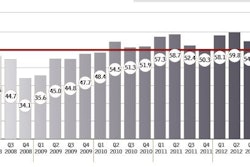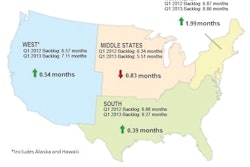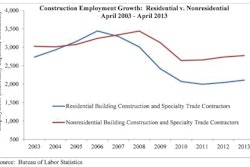Construction employment increased in 170 out of 339 metropolitan areas between April 2012 and April 2013, declined in 123 and was stagnant in 46, according to a new analysis of federal employment data released today by the Associated General Contractors of America. Association officials noted that a majority of metro areas are adding construction jobs as private sector demand accelerates in many parts of the country.
Construction Jobs Data Shows Uneven Signs of Employment Growth
“Demand for construction continues to grow in many parts of the country amid increasing private sector investments in new residential, energy and supply chain facilities like factories, rail lines and warehouses,” said Ken Simonson, the association’s chief economist. “These private sector gains appear strong enough in many parts of the country to outpace declining public sector investments in infrastructure and buildings.”
Highest percentage of construction jobs added:
- Pascagoula, Miss. (45 percent, 1,700 jobs)
- Napa, Calif. (36 percent, 800 jobs)
- Merced, Calif. (19 percent, 300 jobs)
- Baton Rouge, La. (16 percent, 6,600 jobs)
- Lake Charles, La. (16 percent, 1,400 jobs)
Most jobs added in past 12 months:
- Dallas-Plano-Irving (11,500 jobs, 11 percent)
- Houston-Sugar Land-Baytown (11,400 jobs, 6 percent)
- Los Angeles-Long Beach-Glendale, Calif. (9,400 jobs, 9 percent)
- Fort Worth-Arlington, Texas (7,800 jobs, 13 percent)
- Phoenix-Mesa-Glendale, Ariz. (7,500 jobs, 9 percent)
Largest job losses:
- Chicago-Joliet-Naperville, Ill. (-5,900 jobs, -5 percent)
- Northern Virginia (-3,200 jobs, -5 percent)
- Cincinnati-Middletown, Ohio-Ky. (-2,400 jobs, -6 percent)
- Raleigh-Cary, N.C. (-2,300 jobs, -8 percent)
Highest percentage of job losses:
- Bellingham, Wash. (-20 percent, -1,300 jobs)
- Decatur, Ill. (-18 percent, -700 jobs)
- Eau Claire, Wis. (-17 percent, -500 jobs)
- Rockford, Ill. (-17 percent, -700 jobs)
US Construction Industry Loses 6,000 Jobs in April
Association officials said that improving construction employment was masking longer-term problems that could come from declining public sector investments. They noted, for example, that economic growth could suffer as aging transportation infrastructure forces firms to pay more to ship goods. At the same time, increasing construction employment means more areas could experience worker shortages in the near future amid a lack of available workers with experience in certain key construction skills.
“Declining investments in infrastructure and other public assets could ultimately undermine the very growth that is currently boosting employment,” said Stephen E. Sandherr, the association’s chief executive officer. “With hiring on the rebound in many areas, we also need to rebuild vocational education programs and rethink immigration construction caps to ensure there are enough skilled workers available to meet growing demand.”


















